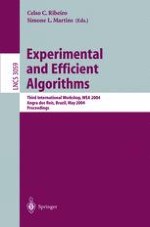2004 | Buch
Experimental and Efficient Algorithms
Third International Workshop, WEA 2004, Angra dos Reis, Brazil, May 25-28, 2004. Proceedings
herausgegeben von: Celso C. Ribeiro, Simone L. Martins
Verlag: Springer Berlin Heidelberg
Buchreihe : Lecture Notes in Computer Science
Enthalten in: Professional Book Archive
